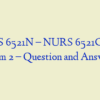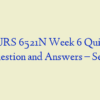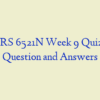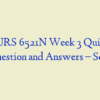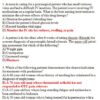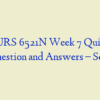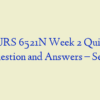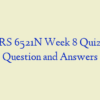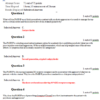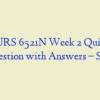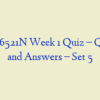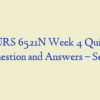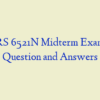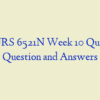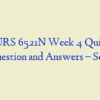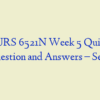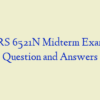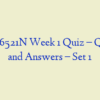Description
NURS 6521N Week 9 Quiz
- A 45-year-old woman with acute leukemia is going to begin chemotherapy with vincristine. The nurse is aware that vincristine must always be administered
- A 62-year-old patient taking tamoxifen exhibits increased bone and tumor pain along with a local disease flare. The nurse interprets this as an indication of which of the following?
- A middle-aged patient has received a diagnosis of GI stromal tumor following an extensive diagnostic workup. Imatinib has been recommended as a component of the patient’s drug regimen. What patient education should the nurse provide to this patient?
- A nurse has completed a medication reconciliation of a patient who has been admitted following a motor vehicle accident. Among the many drugs that the patient has received in the previous year is rituximab. The nurse would be justified in suspecting the patient may have received treatment for which of the following diseases?
- A nurse has been assigned to a 55-year-old woman who has a malignant brain tumor. The patient is receiving her first dose of carmustine. It will be critical for the nurse to observe for which of the following?
- A nurse is caring for a 64-year-old female patient who is receiving IV heparin and reports bleeding from her gums. The nurse checks the patient’s laboratory test results and finds that she has a very high aPTT. The nurse anticipates that which of the following drugs may be ordered?
- An older adult woman has been diagnosed with acute lymphoblastic leukemia (ALL) and her care team has identified potential benefits of imatinib. Which of the following characteristics of this patient’s current health status may preclude the use of imatinib?
- An oncology nurse is reviewing the pathophysiology of cancer and is discussing with a colleague the factors that contribute to the success or failure of a patient’s chemotherapy. Which of the following cancerous cells is most susceptible to the effects of chemotherapeutic drugs?
- Mr. Lepp is a 63-year-old man who was diagnosed with colon cancer several weeks ago and who is scheduled to begin chemotherapy. He reports to the nurse that he read about the need for erythropoietin in an online forum for cancer patients and wants to explore the use of epoetin alfa with his oncologist. Which of the following facts should underlie the nurse’s response to Mr. Lepp?
- A 28-year-old woman has completed rituximab therapy for an autoimmune disease. She tells the nurse that she and her husband would like to start a family. The nurse will advise her to
- Mr. Singh is a 66-year-old man who is receiving chemotherapy for the treatment of lung cancer that has metastasized to his liver. In an effort to prevent infection, Mr. Singh has been prescribed filgrastim (Neupogen). Which of the nurse’s following assessment questions most directly addresses a common adverse effect of filgrastim?
- A patient with chronic lymphocytic leukemia (CLL) will imminently begin a course of treatment with rituximab. In order to minimize the risk of adverse effects, what strategy for administration will be adopted?
- A patient will soon begin targeted therapy as a component of her treatment plan for chronic leukemia. The nurse is conducting health education about this new aspect of the patient’s drug regimen and the patient has asked about the potential side effects of treatment. How should the nurse best respond?
- A patient has been scheduled to begin treatment with rituximab for non-Hodgkin’s lymphoma. The nurse who will administer this drug should understand that it targets
- A male patient is receiving rituximab therapy for non-Hodgkin’s lymphoma. Which of the following would be a priority nursing intervention to reduce the risk for cytotoxicity and tumor lysis syndrome?
- A patient receiving high-dose cisplatin therapy exhibits symptoms of hypomagnesemia. Which of the following should the nurse suggest to help offset the magnesium losses from the cisplatin therapy?
- During ongoing assessment of a patient receiving 5-FU therapy, the nurse finds the patient’s platelet count to be 92,000 cells/mm3. The nurse should do which of the following?
- A nurse on an oncology unit is aware of the need to assess for adverse effects in patients who are being treated with rituximab. The risks of adverse effects are highest at what point during the course of treatment?
- Which of the following patients will be at the greatest risk for anemia and would be the most likely candidate for epoetin alfa therapy?
- An oncology nurse is aware of the risks for injury that exist around the preparation, transportation, and administration of chemotherapeutic agents. In order to reduce these risks of injury, the nurse should take which of the following actions?
- A nurse is discussing oprelvekin therapy with a male patient. Which of the following will the nurse tell the patient is the most common adverse effect of the drug?
- A patient with non-Hodgkin’s lymphoma (NHL) will be starting a course of doxorubicin shortly. When planning this patient’s care, what nursing diagnosis should the nurse prioritize?
- A nurse is caring for a patient with cancer who has been prescribed dronabinol (Marinol) to help reduce nausea and vomiting from chemotherapy. The nurse will inform the patient that he or she is taking an oral form of
- A patient has completed 4 weeks of treatment with epoetin alfa. Which of the following assessment findings would most strongly indicate that treatment has been effective?
- A patient with chronic heart failure has begun treatment with epoetin alfa, which she will receive in her own home from a home health nurse. The nurse should teach the patient to supplement this treatment with a diet that is high in
- When planning care for a patient who is receiving filgrastim (Neupogen) for a nonmyeloid malignancy, the nurse should formulate which of the following patient outcomes? (Select all that apply.)
- A nurse is administering rituximab to a patient via the IV route. The nurse will set the IV pump at 50 mg/hour for the first half hour of the initial infusion. If there are not apparent reactions after 30 minutes of the infusion, the nurse will increase the dosage every 30 minutes by 50 mg/hour until the maximum infusion rate reaches which of the following?
- A male patient is receiving heparin by continuous intravenous infusion. The nurse will instruct the patient and family members to report which of the following should it occur?
- A nurse has administered filgrastim to a diverse group of patients in recent months. Which of the following patients should the nurse observe for extremely elevated white blood cell counts following administration of the drug?
- Intravenous carmustine has been prescribed for a patient with cancer. The nurse should help relieve the discomfort of pain and burning during the infusion by
- A 39-year-old woman is receiving doxorubicin for the treatment of cancer. After each treatment, the patient has acute nausea and vomiting accompanied by a slightly increased heart rate. The nurse will advise her to
- A patient with a recent diagnosis of chronic myelogenous leukemia (CML) is discussing treatment options with his care team. What aspect of the patient’s condition would contraindicate the use of cyclophosphamide for the treatment of leukemia?
- A female patient is prescribed oprelvekin therapy to treat thrombocytopenia. Which of the following should the nurse continuously monitor to determine the efficacy and duration of the oprelvekin therapy?
- A nurse is to use a single-dose 1 mL vial to administer 0.5 mL of epoetin alfa to a 39-year-old woman who is being treated for chemotherapy-induced anemia. Which of the following will the nurse do with the unused portion of the drug?
- A patient’s current course of cancer treatment involves the administration of a conjugated monoclonal antibody. What characteristic of the drug is specified by the fact that it is classified as a conjugated drug?
NURS 6521N Week 9 Quiz
- A 45-year-old woman with acute leukemia is going to begin chemotherapy with vincristine. The nurse is aware that vincristine must always be administered
- A 62-year-old patient taking tamoxifen exhibits increased bone and tumor pain along with a local disease flare. The nurse interprets this as an indication of which of the following?
- A middle-aged patient has received a diagnosis of GI stromal tumor following an extensive diagnostic workup. Imatinib has been recommended as a component of the patient’s drug regimen. What patient education should the nurse provide to this patient?
- A nurse has completed a medication reconciliation of a patient who has been admitted following a motor vehicle accident. Among the many drugs that the patient has received in the previous year is rituximab. The nurse would be justified in suspecting the patient may have received treatment for which of the following diseases?
- A nurse has been assigned to a 55-year-old woman who has a malignant brain tumor. The patient is receiving her first dose of carmustine. It will be critical for the nurse to observe for which of the following?
- A nurse is caring for a 64-year-old female patient who is receiving IV heparin and reports bleeding from her gums. The nurse checks the patient’s laboratory test results and finds that she has a very high aPTT. The nurse anticipates that which of the following drugs may be ordered?
- An older adult woman has been diagnosed with acute lymphoblastic leukemia (ALL) and her care team has identified potential benefits of imatinib. Which of the following characteristics of this patient’s current health status may preclude the use of imatinib?
- An oncology nurse is reviewing the pathophysiology of cancer and is discussing with a colleague the factors that contribute to the success or failure of a patient’s chemotherapy. Which of the following cancerous cells is most susceptible to the effects of chemotherapeutic drugs?
- Mr. Lepp is a 63-year-old man who was diagnosed with colon cancer several weeks ago and who is scheduled to begin chemotherapy. He reports to the nurse that he read about the need for erythropoietin in an online forum for cancer patients and wants to explore the use of epoetin alfa with his oncologist. Which of the following facts should underlie the nurse’s response to Mr. Lepp?
- A 28-year-old woman has completed rituximab therapy for an autoimmune disease. She tells the nurse that she and her husband would like to start a family. The nurse will advise her to
- Mr. Singh is a 66-year-old man who is receiving chemotherapy for the treatment of lung cancer that has metastasized to his liver. In an effort to prevent infection, Mr. Singh has been prescribed filgrastim (Neupogen). Which of the nurse’s following assessment questions most directly addresses a common adverse effect of filgrastim?
- A patient with chronic lymphocytic leukemia (CLL) will imminently begin a course of treatment with rituximab. In order to minimize the risk of adverse effects, what strategy for administration will be adopted?
- A patient will soon begin targeted therapy as a component of her treatment plan for chronic leukemia. The nurse is conducting health education about this new aspect of the patient’s drug regimen and the patient has asked about the potential side effects of treatment. How should the nurse best respond?
- A patient has been scheduled to begin treatment with rituximab for non-Hodgkin’s lymphoma. The nurse who will administer this drug should understand that it targets
- A male patient is receiving rituximab therapy for non-Hodgkin’s lymphoma. Which of the following would be a priority nursing intervention to reduce the risk for cytotoxicity and tumor lysis syndrome?
- A patient receiving high-dose cisplatin therapy exhibits symptoms of hypomagnesemia. Which of the following should the nurse suggest to help offset the magnesium losses from the cisplatin therapy?
- During ongoing assessment of a patient receiving 5-FU therapy, the nurse finds the patient’s platelet count to be 92,000 cells/mm3. The nurse should do which of the following?
- A nurse on an oncology unit is aware of the need to assess for adverse effects in patients who are being treated with rituximab. The risks of adverse effects are highest at what point during the course of treatment?
- Which of the following patients will be at the greatest risk for anemia and would be the most likely candidate for epoetin alfa therapy?
- An oncology nurse is aware of the risks for injury that exist around the preparation, transportation, and administration of chemotherapeutic agents. In order to reduce these risks of injury, the nurse should take which of the following actions?
- A nurse is discussing oprelvekin therapy with a male patient. Which of the following will the nurse tell the patient is the most common adverse effect of the drug?
- A patient with non-Hodgkin’s lymphoma (NHL) will be starting a course of doxorubicin shortly. When planning this patient’s care, what nursing diagnosis should the nurse prioritize?
- A nurse is caring for a patient with cancer who has been prescribed dronabinol (Marinol) to help reduce nausea and vomiting from chemotherapy. The nurse will inform the patient that he or she is taking an oral form of
- A patient has completed 4 weeks of treatment with epoetin alfa. Which of the following assessment findings would most strongly indicate that treatment has been effective?
- A patient with chronic heart failure has begun treatment with epoetin alfa, which she will receive in her own home from a home health nurse. The nurse should teach the patient to supplement this treatment with a diet that is high in
- When planning care for a patient who is receiving filgrastim (Neupogen) for a nonmyeloid malignancy, the nurse should formulate which of the following patient outcomes? (Select all that apply.)
- A nurse is administering rituximab to a patient via the IV route. The nurse will set the IV pump at 50 mg/hour for the first half hour of the initial infusion. If there are not apparent reactions after 30 minutes of the infusion, the nurse will increase the dosage every 30 minutes by 50 mg/hour until the maximum infusion rate reaches which of the following?
- A male patient is receiving heparin by continuous intravenous infusion. The nurse will instruct the patient and family members to report which of the following should it occur?
- A nurse has administered filgrastim to a diverse group of patients in recent months. Which of the following patients should the nurse observe for extremely elevated white blood cell counts following administration of the drug?
- Intravenous carmustine has been prescribed for a patient with cancer. The nurse should help relieve the discomfort of pain and burning during the infusion by
- A 39-year-old woman is receiving doxorubicin for the treatment of cancer. After each treatment, the patient has acute nausea and vomiting accompanied by a slightly increased heart rate. The nurse will advise her to
- A patient with a recent diagnosis of chronic myelogenous leukemia (CML) is discussing treatment options with his care team. What aspect of the patient’s condition would contraindicate the use of cyclophosphamide for the treatment of leukemia?
- A female patient is prescribed oprelvekin therapy to treat thrombocytopenia. Which of the following should the nurse continuously monitor to determine the efficacy and duration of the oprelvekin therapy?
- A nurse is to use a single-dose 1 mL vial to administer 0.5 mL of epoetin alfa to a 39-year-old woman who is being treated for chemotherapy-induced anemia. Which of the following will the nurse do with the unused portion of the drug?
- A patient’s current course of cancer treatment involves the administration of a conjugated monoclonal antibody. What characteristic of the drug is specified by the fact that it is classified as a conjugated drug?


